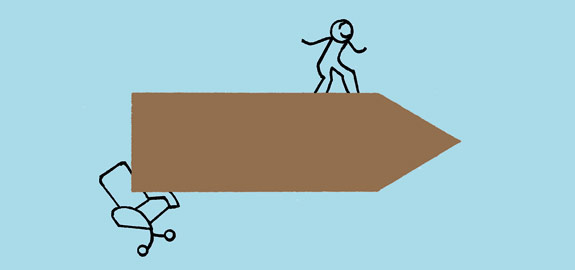Creativity can come out of nowhere. The trick is to sense it—and ride it to the end.
From the July/August 2011 issue of Inc. magazine A few weeks ago, I was on fire. I was working on some designs for a prototype of a new software product, and the ideas were flowing as they hadn't in months. Every day, I felt as if I were accomplishing two or three days' worth of work. I was in the zone, and it felt fantastic.
A few weeks ago, I was on fire. I was working on some designs for a prototype of a new software product, and the ideas were flowing as they hadn't in months. Every day, I felt as if I were accomplishing two or three days' worth of work. I was in the zone, and it felt fantastic.
From the July/August 2011 issue of Inc. magazine
 A few weeks ago, I was on fire. I was working on some designs for a prototype of a new software product, and the ideas were flowing as they hadn't in months. Every day, I felt as if I were accomplishing two or three days' worth of work. I was in the zone, and it felt fantastic.
A few weeks ago, I was on fire. I was working on some designs for a prototype of a new software product, and the ideas were flowing as they hadn't in months. Every day, I felt as if I were accomplishing two or three days' worth of work. I was in the zone, and it felt fantastic.It lasted about three weeks. And then I found myself back at my old pace. Instead of being superproductive, I was sort-of productive. Some days, I felt as if I barely accomplished anything.
I believe it's perfectly fine to spend some of your time, maybe even a lot of your time, not firing on all cylinders. Just like full employment isn't necessarily good for an economy, full capacity isn't always great for your mind.
This will be anathema to the multitudes who worship at the altars of Motivation and its close relation, Productivity. Indeed, when I meet with ambitious young entrepreneurs, I am invariably asked, "How can I get more done in fewer hours? What can I do to jump-start my creativity? How can I keep my edge?"
Here are the three answers I can offer: 1. You can't. 2. Stop trying so hard—if it feels like work, something's wrong. 3. Do less stuff.
Motivation, productivity, efficiency—these things are not constants. In my experience, they come in waves. They ebb and flow, and there's no sense in fighting it. The key is to recognize a productivity surge when it appears, so you can roll with it.
I think about work the same way I think about the weather. Sometimes it's snowy or rainy or foggy at work. When that happens, I stay "inside"—and take care of the busy work, the boring stuff, the small things that need to get done. But when things warm up, it's time to head "outside," to get creative, focus on the interesting problems, and ride the wave of creativity as long as it lasts. It may be days, weeks, even months.
This doesn't apply only to those who are in charge. If you manage people, it's important to remember that your employees and colleagues are human, too. They won't always be motivated to do what you'd like them to do when you want them to do it. Their creativity will ebb and flow, just like yours.
This, of course, is a source of frustration for many managers, who continue to believe that if they change this or tinker with that, they'll be able to squeeze more of the good stuff out of their people. But you can artificially motivate someone for only so long. It's nearly impossible to fight the natural rhythm of motivation and productivity. You're better off recognizing that than waging war against reality.
Of course, that does not mean you should simply sit back and do nothing. When I detect that an ordinarily creative employee hasn't been in the flow for a while, I will ask him or her about it, try to get the issue out in the open. In some cases, it turns out that he or she is simply not interested in his or her current project. Other times, there are external issues—such as a personal crisis—that cause motivation to flag.
If it's something I can help with, I often suggest shifting to another part of the project that's more in line with his or her motivations. If it's something beyond my control, I just let it work its way out of the employee's system. If it becomes a long-term issue, then there's a problem that needs to be addressed by other means. In fact, we recently instituted 30-day paid sabbaticals for every three years worked. This is in addition to standard vacation time. So far, one person has taken us up on it. No one was particularly surprised when he returned to work more motivated—and productive—than ever.
Jason Fried is co-founder of 37signals, a Chicago-based software firm, and co-author of the book Rework, which was published last March.